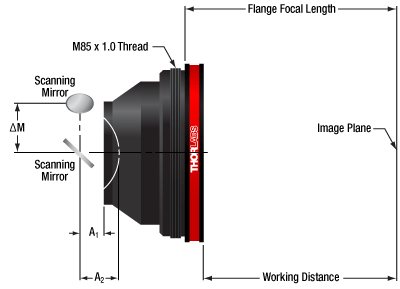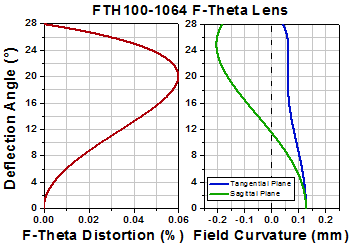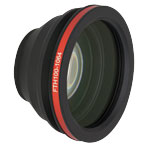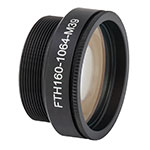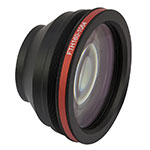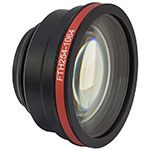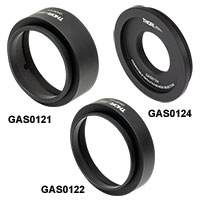
F-Theta Scan Lenses
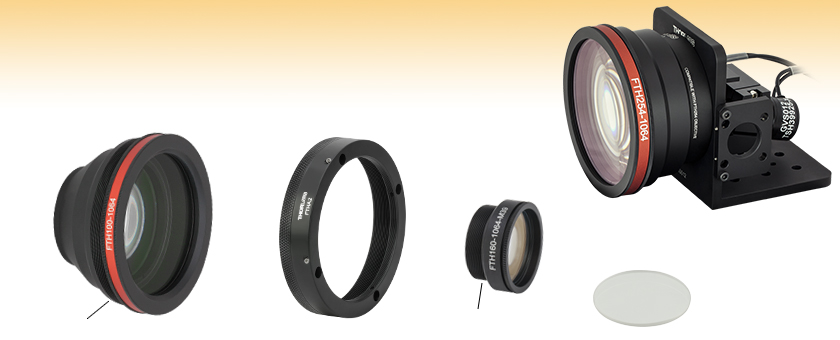
- Scan Lenses for Laser Marking, Engraving, and Cutting Systems
- 1064 nm Design Wavelength
- Focal Length: 100 mm, 160 mm, or 254 mm
- Galvo Mounting Bracket Available
FTH100-1064
FTH160-1064-M39
M85 x 1.0 Thread
M39 x 1.0 Thread
FTH254-1064 Lens and
GVS012 Galvo Mirror
Pair in a GAS012
Mounting Bracket
FTHW42-1064
Replacement Protective
Window
FTHA1
60 mm Cage System or
SM3 Lens Tube Adapter
OVERVIEW
| Objective Lens Selection Guide |
|---|
| Objectives |
| Super Apochromatic Microscope Objectives Microscopy Objectives, Dry Microscopy Objectives, Oil Immersion Physiology Objectives, Water Dipping or Immersion Phase Contrast Objectives Long Working Distance Objectives Reflective Microscopy Objectives UV Focusing Objectives VIS and NIR Focusing Objectives |
| Scan Lenses and Tube Lenses |
| Scan Lenses F-Theta Scan Lenses Infinity-Corrected Tube Lenses |
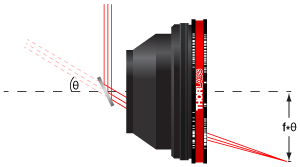
Click to Enlarge
Figure 1.1 In an f-theta lens, the output beam displacement is proportional to the product of focal length f and scan angle θ. For more details, please see the F-Theta Tutorial tab.
| Click on the red Document icon next to the item numbers below to access the Zemax file download. Our entire Zemax Catalog is also available. |
Features
- 1064 nm Design Wavelength for Nd:YAG Laser Systems
- Flat Field at the Image Plane
- Large Scan Fields Ranging from 70 mm x 70 mm to 156.7 mm x 156.7 mm
- F-Theta Distortion of <0.1% or <1.3%
- M85 x 1.0- and M39 x 1.0-Threaded Versions Available
- Air-Spaced Design
- All Optical Elements are AR Coated
- Accessories Available Below:
- Replacement Protective Glass Windows
- Galvo Mirror Mounting Bracket
- Mounting Adapters for 60 mm Cage Systems, Ø2" Lens Tubes, or Ø3" Lens Tubes
Thorlabs' F-Theta Lenses consist of an air-spaced 2- or 3-element design and are available with one of three focal lengths: 100 mm, 160 mm, or 254 mm. The elements are coated with a high efficiency AR coating for a 1064 nm Nd:YAG laser and for a visible alignment laser (refer to the Graphs tab for details). Each housing has a standard M85 x 1.0 or M39 x 1.0 thread for compatibility with most commercial laser marking systems, including ScanLAB, TRUMPF, and Datalogic, as well as a protective glass window that can be easily changed using the instructions provided below. Replacement AR-coated protective windows are also available.
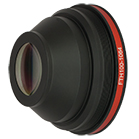
Click to Enlarge
Figure 1.2 FTH100-1064 Rear View
F-theta lenses are the standard lenses for galvo-scanner-based laser marking, engraving, and cutting systems. The diffraction-limited, multiple-element, air-spaced lens design is optimized for a flat field in the image plane and low f-theta distortion. In an f-theta lens, the output beam displacement is equal to f*θ, where θ is the angle of incidence of the input beam (see Figure 1.1). Thus, the input beam and output beam angular velocities are directly proportional, allowing the scanning mirrors to run at a constant angular velocity, greatly simplifying control electronics. For more details on f-theta lenses, please see the F-Theta Tutorial tab.
Mounting Options
These f-theta lenses are compatible with our Large Beam Galvo Mirror Systems. We also offer the GAS012 Mounting Bracket, sold below, which allows our f-theta lenses to be mounted at the proper distance from our galvo mirrors. Alternatively, we offer adapters for mounting our FTH100-1064, FTH160-1064, and FTH254-1064 lenses to 60 mm Cage Systems or SM3 (3.035"-40) Lens Tubes. The FTH160-1064-M39 F-Theta Lens can be adapted to our SM2 (2.035"-40) Lens Tubes using our SM2A29 External SM2 to Internal M39 x 1.0 thread adapter.
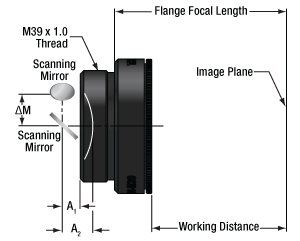
Click to Enlarge
Figure 1.4 FTH160-1064-M39 Schematic
GRAPHS
The shaded regions of the plots are the wavelength ranges over which the coating is specified: 450 nm - 700 nm (Ravg < 1.0% per surface) and 1020 nm - 1080 nm (Ravg < 0.3% per surface). Performance outside of these ranges is not guaranteed. The visible AR coating range is intended to allow use with an alignment laser. The other lens specifications are not optimized for performance at visible wavelengths.
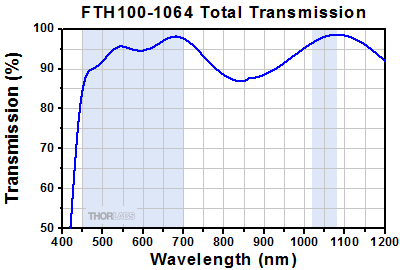
Click to Enlarge
Click Here for Raw Data
The FTH100-1064, FTH160-1064, and FTH254-1064 lenses all have three optical elements, not including the protective window. The FTH160-1064 and FTH254-1064 lenses have similar transmission to the plot shown above, only differing due to different element thicknesses.

Click to Enlarge
Click Here for Raw Data
The FTH160-1064-M39 lens has two optical elements, not including the protective window.
F-THETA TUTORIAL
F-Theta Lenses
F-theta lenses have been engineered to provide the highest performance in laser scanning or engraving systems. These lenses are ideal for engraving and labeling systems, image transfer, and material processing. For many applications in laser scanning and engraving, a planar imaging field is desired for the best results. A spherical lens can only image along a circular plane [see Figure 3.1 (a)]. The flat-field scanning lens solves this problem. However, the displacement of the beam depends on the product of the effective focal length (f) and the tangent of the deflection angle θ [f × tan (θ), see Figure 3.1 (b)].
While this nonlinear displacement can be accounted for with the proper software algorithm, the ideal solution is to produce a linear displacement (i.e., constant scan rate). F-theta lenses are designed with a barrel distortion that yields a displacement that is linear with θ [f*θ, see Figure 3.1 (c)]. This simple response removes the need for complicated electronic correction and allows for a fast, relatively inexpensive, and compact scanning system.
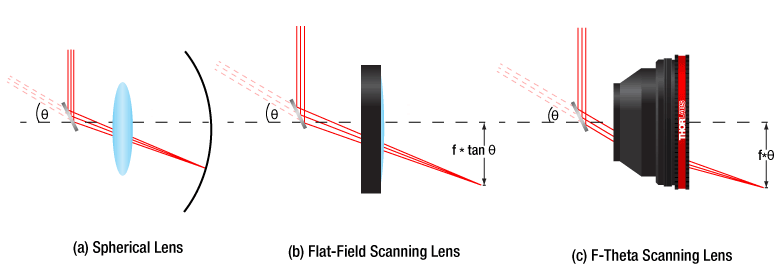
Click to Enlarge
Figure 3.1 Scanning Lenses
F-theta lenses solve many of the problems associated with laser scanning. Additionally, the compact design of the f-theta lens allows the user to reduce the number of optical components needed to provide a flat image plane. These lenses are able to realize tighter spot sizes, which translate into higher resolution for scanning or printing, as well as higher intensity for engraving or welding. Most importantly, the spot size (resolution and intensity) are nearly constant across the entire image plane.
Scan Lens Setup
Laser scanning systems are optimized for precision control of a laser’s beam waist size (diameter of the focused spot) and the accurate position of that waist. Typically a laser scanning system will incorporate one or two scan mirrors, depending on function. For instance, in a single mirror system, the mirror will be placed at the entrance pupil position of the f-theta lens. In a two mirror system, the entrance pupil of the f-theta lens is placed between the two mirrors. To maximize the performance of the f-theta lens, the mirror separation should be minimized.
Scan Lens Characteristics
Some of the most important factors to consider when selecting a f-theta lens are operating wavelength, spot size, and scan field diameter (SFD). Through these parameters, the user may then place further constraints upon a scanning system such as entrance beam diameter, scanning mirror deflection, mirror placement, and mirror position.
Scan Field Diameter (SFD), or Scan Length, is the diagonal length of a square area in the image plane where the beam can be focused by the lens. This specification helps define deflection (along with the focal length). Output Scan Angle (OSA) is the angle between the output laser beam after it has passed through the scan lens and the normal of the image plane. The OSA will vary across the image field, although for scanning or engraving the change in OSA will not largely impact dynamics. It should be noted that the OSA is always zero for telecentric lenses. Back Focal Length (BFL) is the distance between the apex of the physical lens (outer glass element) to paraxial focus point. Back Working Distance (BWD) is simply the distance between the housing of the lens to the paraxial focus point.
Another important parameter to consider is field distortion and curvature. While f-theta lenses are well designed to provide a flat image plane, a real lens rarely measures up to the theoretical. There will be some amount of distortion and curvature. Figure 3.2 shows these parameters for our FTH100-1064 f-theta lens, where focal length is 100 mm and the maximum deflection angle is 28°. Figure 3.2 shows both the field curvature in millimeters and f-theta distortion in percent as a function of scan angle. Typically in constructing a scanning system, it is best to place the zero-curvature point at the midrange of the scan to help limit the amount of curvature realized during the scan.
Summary
As stated previously, the goal of the laser system is to produce a spot size appropriate for the necessary resolution and to accurately position that spot anywhere in a flat image plane. Diffraction-limited scanning lenses, in general, will produce a spot size given by

where Spot Size is the 1/e2 beam diameter, λ is the wavelength of the laser, f is the effective focal length of the lens, and A is the entrance beam diameter. C is a constant that relates to the degree of pupil illumination and input truncation (for a Gaussian beam, C = 1.83 when the entrance beam is truncated at the 1/e2 diameter).
The focal length also influences the diameter of the scan field, which is given by

where L is the diagonal of the square scan field, θ is the maximum deflection angle in radians, and again f is the effective focal length of the lens. By maximizing θ, the focal length can be minimized in a system. In general this is the preferred method of maintaining L since it will reduce the necessary size of the optics resulting in a more compact and cost effective system. Additionally, f-theta distortions caused by motor instabilities of the scanning mirrors will be reduced since these distortions scale with the EFL (smaller EFL results in smaller distortions).
F-Theta Scan Lenses
Part Number | Description | Price | Availability |
|---|---|---|---|
FTH100-1064 | F-Theta Scan Lens, f = 100 mm, 1064 nm Design Wavelength, M85 x 1.0 | $972.38 | Today |
FTH160-1064-M39 | F-Theta Scan Lens, f = 160 mm, 1064 nm Design Wavelength, M39 x 1.0 | $681.29 | Today |
FTH160-1064 | F-Theta Scan Lens, f = 160 mm, 1064 nm Design Wavelength, M85 x 1.0 | $1,011.78 | Lead Time |
FTH254-1064 | F-Theta Scan Lens, f = 254 mm, 1064 nm Design Wavelength, M85 x 1.0 | $1,559.61 | Today |
Protective Windows for F-Theta Scan Lenses
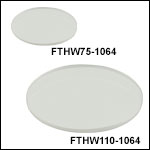
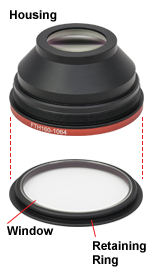
Click for Details
Figure G2.1 Changing the Window of an F-Theta Scan Lens
- Replacement Protective Windows for F-Theta Scan Lenses
- Available with Ø42 mm, Ø75 mm, or Ø110 mm
- Easy to Install
Replacement protective windows for the f-theta scan lenses sold above are available here. The windows have an AR coating optimized for 1064 nm (the design wavelength of the f-theta lenses) and the 450 to 700 nm range (allowing a visible laser to be used for alignment purposes).
To change a window, unscrew the front retaining ring from the larger aperture of the f-theta lens. After removing the old window, hold the retaining ring so that the threaded side is facing up (see Figure G2.1). Place the new protective window inside the recessed area in the center of the ring. Hold the f-theta lens housing so that the large aperture is facing downwards, and screw the retaining ring back into the housing to secure the window.
| Table G2.2 Specifications | |||
|---|---|---|---|
| Item # | FTHW75-1064 | FTHW42-1064 | FTHW110-1064 |
| Compatible Lenses | FTH100-1064, FTH160-1064 | FTH160-1064-M39 | FTH254-1064 |
| Diameter | 75 mm (2.95") | 42 mm (1.65") | 110 mm (4.33") |
| Diameter Tolerance | +0 mm / -0.1 mm | +0 mm / -0.15 mm | +0.5 mm / -1.0 mm |
| Thickness | 2.0 mm (0.08") | 1.6 mm (0.06") | 3.0 mm (0.12") |
| Thickness Tolerance | ±0.1 mm | ||
| Parallelism | ≤3 arcmin | ≤2 arcmin | ≤3 arcmin |
| Clear Aperture | Ø71 mm | Ø40 mm | Ø104 mm |
| Substrate | N-BK7 | ||
| Surface Quality | 20-10 Scratch-Dig | ||
| Transmitted Wavefront Error (Peak to Valley) |
<1λ @ 633 nm | <1λ @ 633 nm | <1.5λ @ 633 nm |
| AR Coatinga | 1020 nm - 1080 nm: Ravg <0.3% (per Surface) 450 nm - 700 nm: Ravg < 1.0% (per Surface) |
||
| Damage Threshold | 20 J/cm2 (1064 nm, Ø1 mm, 10 ns, 10 Hz) | ||
Part Number | Description | Price | Availability |
|---|---|---|---|
FTHW75-1064 | Protective Window for FTH100-1064 and FTH160-1064 F-Theta Scan Lenses | $122.03 | In Stock Overseas |
FTHW42-1064 | Protective Window for FTH160-1064-M39 F-Theta Scan Lens | $122.03 | Today |
FTHW110-1064 | Protective Window for FTH254-1064 F-Theta Scan Lens | $251.67 | Lead Time |
Galvo Mirror and Scan Lens Mounting Bracket
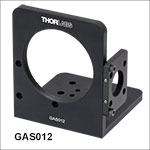
- Mounting Bracket for Integrating our F-Theta Scan Lenses with our Large Beam Galvo Mirror Pair
- Removable 30 mm-Cage- and SM1-Thread-Compatible Input Plate
- Thread Adapters (Sold Below) Required for Attaching F-Theta Lenses
- Compatible with Imperial or Metric Breadboards and Optical Tables
The GAS012 Mounting Bracket allows for the integration of our M85-threaded or M39-threaded f-theta scan lenses with our large-beam-diameter dual-axis galvanometer mirror pairs. It also allows the complete assembly to be integrated with optical-table- or breadboard-based optomechanical setups. To use the GAS012 mounting bracket, a thread adapter (also sold below) must also be purchased. This places the lens at the recommended distance, A1, from the second galvo mirror (see diagrams in the Overview tab). See Table G3.1 for a description of which adapter is compatible with each f-theta lens.
The bracket's input light port is a plate that features both SM1 (1.035"-40) threading and four Ø6 mm cage rod through holes for Ø1" lens tube and 30 mm cage system integration, respectively. The GAS012 bracket has a bottom mounting surface with eight #8 (M4) and nine 1/4" (M6) through holes, spaced at 12.6 mm (0.496") and 25.2 mm (0.99"), respectively, for compatibility with both imperial and metric breadboards and optical tables. When mounted, the GVS012(/M) galvo mirror pair does not sit directly on this surface, allowing all of the through holes to be used for table or breadboard mounting.
| Table G3.1 Adapter Compatibility | |||
|---|---|---|---|
| Mounting Bracket Item # | GAS012 | ||
| Thread Adapter Item # | GAS0121 | GAS0122 | GAS0124 |
| Compatible Scan Lens | FTH100-1064 FTH160-1064 |
FTH254-1064 | FTH160-1064-M39 |
| Compatible Galvo Mirror System | Large Beam Diameter Dual-Axis Galvo Systems | ||
| Assembled System Photo (Click for Details) |
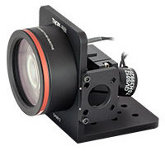 |
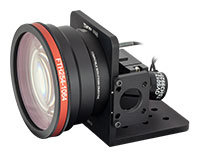 |
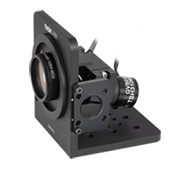 |
Part Number | Description | Price | Availability |
|---|---|---|---|
GAS012 | Customer Inspired! Scan Lens and Galvo Mirror System Mounting Bracket (Required Thread Adapter Sold Separately) | $202.10 | Today |
GAS0121 | Scan Lens Thread Adapter for GAS012 and FTH100-1064 or FTH160-1064 | $74.44 | Today |
GAS0124 | Scan Lens Thread Adapter for GAS012 and FTH160-1064-M39 | $74.44 | Today |
GAS0122 | Scan Lens Thread Adapter for GAS012 and FTH254-1064 | $74.44 | Today |
Mounting Adapters for Lens Tubes and Cage Systems
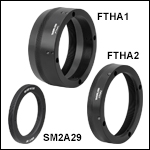
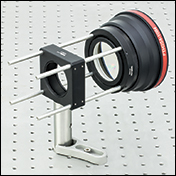
Click to Enlarge
Figure 535B FTH254-1064 Lens Mounted in 60 mm Cage System Using the FTHA2 Adapter, an LCP34T(/M) Cage Plate, and a Ø1" Pedestal Post
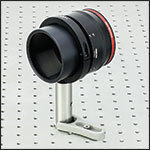
Click to Enlarge
Figure 535A FTH100-1064 Lens Mounted to Ø3" Lens Tube Using the FTHA1 Adapter, an SM3TC Post Mounting Adapter, and a Ø1" Pedestal Post
- Integrate an FTH100-1064, FTH160-1064, and FTH254-1064 Lens with a Ø3" Lens Tube or a 60 mm Cage System
- Integrate an FTH160-1064-M39 Lens with a Ø2" Lens Tube
These mounting adapters connect our f-theta scan lenses to our lens tube systems. The SM2A29 adapter offers external SM2 (2.035"-40) threads for mating our
FTH160-1064-M39 F-Theta Lens with an SM2 Lens Tube. The FTHA1 and FTHA2 adapters each feature four bores for Ø6 mm cage rods for integrating with 60 mm cage systems and internal SM3 threads for mounting to Ø3" lens tubes. These support methods cannot be used simultaneously due to mechanical clashing. For compatibility, please see Table 535C.
| Table 535C Adapter Compatibility | |||
|---|---|---|---|
| Adapter Item # |
FTHA1 | FTHA2 | SM2A29 |
| Compatible Scan Lens |
FTH100-1064 FTH160-1064 |
FTH254-1064 | FTH160-1064-M39 |
| Mounting Compatibility |
60 mm Cage Systems Ø3" Lens Tubes |
Ø2" Lens Tubes | |
Note: Due to the mass of our M85 x 1.0-threaded f-theta lenses, we strongly recommend supporting the cage system or lens tube and making the lever arm between the support and the lens as short as possible. For examples, see Figures 535A and 535B.
Assembly Diagrams

Click to Enlarge
Figure 535D FTH100-1064 Lens Mounted in FTHA1 Adapter

Click to Enlarge
Figure 535E FTH160-1064 Lens Mounted in FTHA1 Adapter

Click to Enlarge
Figure 535F FTH254-1064 Lens Mounted in FTHA2 Adapter

Click to Enlarge
Figure 535G FTH160-1064-M39 Lens Mounted in SM2A29 Adapter
Part Number | Description | Price | Availability |
|---|---|---|---|
FTHA1 | Customer Inspired! 60 mm Cage System and SM3 Lens Tube Adapter for FTH100-1064 or FTH160-1064 Lenses | $65.46 | Today |
FTHA2 | Customer Inspired! 60 mm Cage System and SM3 Lens Tube Adapter for FTH254-1064 Lens | $65.46 | Today |
SM2A29 | Adapter with External SM2 Threads and Internal M39 x 1.0 Threads | $42.02 | Today |

